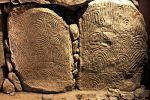Latitude 47, 571835 Longitude -2,898588. In the Gulf of Morbihan, 1 mile south of Larmor-Baden in the Bretagne-Morbihan region of Brittany, is Gavrinus Island (Ile de Gavrinis) with, what is considered, a world-famous prehistoric burial mound called Gavrinis Tumulus. The burial chamber at the south side of the island is ‘variously’ referred to as a tumulus or cairn, dating back to the Neolithic 5,000 to 6,000 years. It is said by those historians that are proficient in this type of ancient monument to be the best-preserved passage grave in Brittany, and maybe Europe, if not the world, though there are other “equally good” burial mounds in Europe, one in particular being Newgrange in Southern Ireland. Gavrinis means Isle of Goats. To reach the island of Gavrinis you need to get a boat from the embarking point in the port of Larmor-Baden, but it’s only a short trip of 10 minutes! The town of Vannes is some 12 miles to the north-east on the D136 and D101 roads.
The great mound of Gavrinis measures 23 feet in height (7 metres) and is 328 feet in circumference (100 metres). The diameter of the mound is between 50 and 60 metres (164 feet to 196 feet). It was built around 3,500 BC and was made of earth and large stones that are piled on to the top of the burial mound. Deep inside the mound a gallery (passage) 43 feet long is covered over by stones – with 50 slabs, 23 of these are supporting slabs on top of which there are 9 capstones or tables, leading to a square-shaped burial chamber. The stone supports are richly adorned with beautiful carvings, including pattern-work, symbolism, animals and what could be a human figure – also zigzag decoration, lozenge shapes, abstract circles, axes, arcs, and snake-lines. Undoutedly, this was a funery tomb for some high-ranking person, maybe a chieftain or a king; the ceiling above is made of a large (single) stone-slab measuring 12 feet (4 metres) long by 9 feet (3 metres) wide and weighing upto 17 tons, which rests upon 8 more stone supports standing in a rectangle. The entrance (portal) is built with large slabs, two at the sides and one at the top, while the sides (faces) of the mound are stepped or tiered with thousands of large lumps of stone, not to disimilar perhaps to the pyramids at Giza in Egypt! There are some ‘spectacular’ panoramic views to be had from the tumulus of Gavrinis of the Gulf of Morbihan and the surrounding areas for many miles around, in every direction!
Gavrinis was discovered back in 1832 and excavations began in 1835. In more recent years, the 1960s through to the 1980s there have been further excavations and, in recent years (2011) the decorated stone slabs from inside the chamber have been ‘thoroughly’ researched. A few miles to the south is the tiny island of Er Lanic and two stone circles (together) in the form of a figure-eight – half of the circle now being submerged in the sea. To the north of Gavrinis Island, near Auray, stands the burial chamber or tumulus of Er Grah and, near that close to Locmariquer is Les Table des Marchand. The renowned archaeologist and writer, Aubrey Burl, visited Gavrinis and ‘seems’ to have been “very enthusiastic” about what he had seen of the cairn. Burl was later to describe this and other ancient monuments in his book ‘Megalithic Brittany,’ 1988. Burl said of Gavrinis “It is for its art that Gavrinis is famous.”
Sources:
Michelin Tourist Guide ‘Brittany’, Michelin Tyres Plc, London, 1983.
Insight Guides ‘Brittany’, Ed: Brian Bell, (First Edition) APA Publications (HK) Limited, 1994.
Burl, Aubrey., Megaliths of Brittany, Thames & Hudson, London, 1985.
http://en.wikipedia.org/wiki/Gavrinis
http://www.knowth.com/gavrinis.htm
http://www.academia.edu/5015454/Gavrinis._The_raising_of_digital_stones
Copyright © Ray Spencer, The Journal of Antiquities, 2014 (updated 2023).


